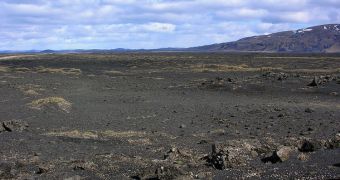Perfect environment for microbial life most likely existed on the surface of the Red Planet billions of years ago. A new study indicates that widespread glass fields throughout Mars' northern hemisphere may have been hot spots for life before the world lost its surface water.
According to geologists, glass sands at these locations mostly formed when magma flowing on the planet's surface met water or ice. The interaction would have led to the creation of this material, while at the same time providing an excellent environment for microorganisms to thrive in.
Most glass fields are found in lowlands that spread across millions of square miles on Mars' northern hemisphere. Scientists first discovered the dark deposits years ago, but how they formed, and their origins, have remained somewhat of a mystery.
In order to gain a deeper insight into the deposits, scientists at the Arizona State University (ASU) have recently used the European Space Agency (ESA) Mars Express orbiter to analyze the light being reflected from the weird Martian plains.
They determined that the only material that could reflect light in the manner Mars Express observed was sand made out of glass. “We're actually seeing glass particles, like glass sand,” says ASU expert Briony Horgan, who conducted the work with colleague James Bell.
It's interesting to note here that plains similar to the ones on Mars exist on Earth as well. The Árskógar region of Iceland boasts thousands of square miles dominated by glass sand. Therefore, this region could serve as a proxy for studying the Red Planet, astronomers explain.
“The only way to create an extensive glassy deposit like that is through explosive volcanism. This is the first direct evidence on Mars for explosive volcanism on a planetary scale,” Horgan adds. Iceland, for example, was entirely generated through volcanism.
“When lava or magma interacts with ice or water, it is quenched, which means it rapidly cools and solidifies. This rapid cooling prevents any crystals from growing, and so a volcanic glass is produced,” University of London expert Claire Cousins comments. She was not a part of the new study.
More and more, studies of Mars are beginning to depict a planet that may have once supported life rather easily. This raises the tantalizing prospect of various lifeforms having moved to the Martian underground.
Given the resilience of bacteria we see on Earth, and the fact that microbes can even live under oceanic crusts, this possibility is a rather realistic one, Astrobiology Magazine reports.

 14 DAY TRIAL //
14 DAY TRIAL //